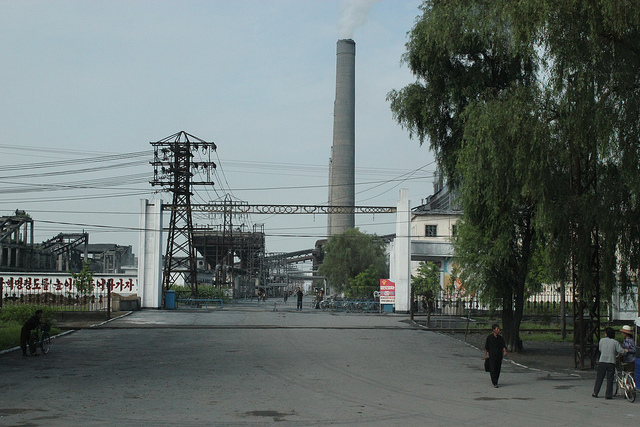Soho Line on:
[Wikipedia]
[Google]
[Amazon]
The Sŏho Line is an electrified narrow gauge railway line of the
 The Sŏho Line is used exclusively for passenger trains for commuters.
The Sŏho Line is used exclusively for passenger trains for commuters.
Korean State Railway
The Korean State Railway (), commonly called the State Rail () is the operating arm of the Ministry of Railways of North Korea and has its headquarters at P'yŏngyang. The current Minister of Railways is Chang Jun Song.
History
1945–195 ...
in Hamhŭng-si, North Korea
North Korea, officially the Democratic People's Republic of Korea (DPRK), is a country in East Asia. It constitutes the northern half of the Korea, Korean Peninsula and shares borders with China and Russia to the north, at the Yalu River, Y ...
, running from Hamhŭng
Hamhŭng (''Hamhŭng-si''; ) is North Korea's second-largest city, and the capital of South Hamgyŏng Province. It has an estimated population of 768,551. Located in the southern part of the South Hamgyong province, Hamhung is the main and most p ...
to Hŭngnam
Hŭngnam is a district of Hamhung, the second largest city in North Korea. It is a port city on the eastern coast on the Sea of Japan. It is only from the slightly inland city of Hamhung. In 2005 it became a ward of Hamhung.
History
The port a ...
and Sŏho.Kokubu, Hayato, 将軍様の鉄道 (Shōgun-sama no Tetsudō),
History
During the Japanese colonial era, the privately owned Sinhŭng Railway built a network of narrow-gauge railways around Hamhŭng. These were the Hamnam Line, theJangjin Line
The Jangjin Line (長津線, ''Chōshin-sen'') was a narrow gauge railway line of the Chōsen Railway of colonial-era Korea, located in South Hamgyeong Province.Kokubu, Hayato, 将軍様の鉄道 (Shōgun-sama no Tetsudō), There is a cable ...
, and the Songheung Line
The Songheung Line (松興線, ''Shōkō-sen'') was a narrow gauge railway line of the Chōsen Railway (Chōtetsu) of colonial-era Korea, located in South Hamgyeong Province.Kokubu, Hayato, 将軍様の鉄道 (Shōgun-sama no Tetsudō), Ther ...
opened between 1923 and 1933, and the Namhŭng Line, which was opened in three sections between 1934 and 1936.
The Sinhŭng Railway was bought by the Chosen Railway
The Chosen Railway Company (Japanese: 朝鮮鉄道株式会社, ''Chōsen Tetsudō Kabushiki-gaisha''; Korean: 조선철도주식회사, ''Joseon Cheoldo Jusikhoesa''), was a privately owned railway company in Japanese-occupied Korea.
History
The ...
on 22 April 1938.
After the defeat of Japan
Japan ( ja, 日本, or , and formally , ''Nihonkoku'') is an island country in East Asia. It is situated in the northwest Pacific Ocean, and is bordered on the west by the Sea of Japan, while extending from the Sea of Okhotsk in the north ...
in the Pacific War
The Pacific War, sometimes called the Asia–Pacific War, was the theater of World War II that was fought in Asia, the Pacific Ocean, the Indian Ocean, and Oceania. It was geographically the largest theater of the war, including the vast ...
and the subsequent partition of Korea
The division of Korea began with the defeat of Japan in World War II. During the war, the Allied leaders considered the question of Korea's future after Japan's surrender in the war. The leaders reached an understanding that Korea would be li ...
, the entirety of the line, being north of the 38th parallel, was located in the Soviet
The Soviet Union,. officially the Union of Soviet Socialist Republics. (USSR),. was a List of former transcontinental countries#Since 1700, transcontinental country that spanned much of Eurasia from 1922 to 1991. A flagship communist state, ...
zone of occupation; on 10 August 1946, the Provisional People's Committee for North Korea
The Provisional People's Committee of North Korea was the provisional government of North Korea.
The committee was established on 8 February 1946 in response for the need of the Soviet Civil Administration and the communists to have centralizatio ...
nationalised all railways within its jurisdiction, including the Namhŭng Line, and it has since been operated by the Korean State Railway
The Korean State Railway (), commonly called the State Rail () is the operating arm of the Ministry of Railways of North Korea and has its headquarters at P'yŏngyang. The current Minister of Railways is Chang Jun Song.
History
1945–195 ...
.
Originally built entirely as a narrow gauge line, frequent accidents on the line led the Korean State Railway to convert the Hamhŭng—Sinhŭng section of the Sinhŭng Line to standard gauge for greater safety and increased transportation capacity; after the regauging of this section was completed, West Hamhŭng station was disconnected from the Sinhŭng line. When Naeho Station was closed, the line between Hadŏk and Sŏho was realigned to the current, shorter alignment.
In 2017, the line was reconstructed with the participation of the Hamhung Narrow Gauge Railroad office, Yonggwang Yonju plant and organised by the South Hamgyong provincial party office. Stations, sleepers and concrete poles were all replaced. Hungdok station was rebuilt as a model station.
Services
 The Sŏho Line is used exclusively for passenger trains for commuters.
The Sŏho Line is used exclusively for passenger trains for commuters.
Route
The pink background indicates that that section is electrified narrow gauge.Rolling stock
The line uses Charyokkaengsang-class locomotives (Korean: 자력갱생) originally built byKim Chong-t'ae Electric Locomotive Works
The Kim Chong-t'ae Electric Locomotive Works () in P'yŏngyang is North Korea's largest manufacturer of railway equipment. Established in November 1945 in Sŏsŏng-guyŏk, P'yŏngyang near the P'yŏngyang Railway University and the Korean Stat ...
. They have 551kW motors and haul a number of passenger cars. These locomotives underwent complete body replacement by the 8 February Vinylon Factory and the Hamhung Narrow Gauge Office in 2017 and received a blue and white exterior along with the reconstruction of the line. Previously, the locomotives were yellow and red. A total of 8 locomotives and 22 passenger cars which were overhauled.
References
* {{DEFAULTSORT:Soho Line Railway lines in North Korea 2 ft 6 in gauge railways in North Korea